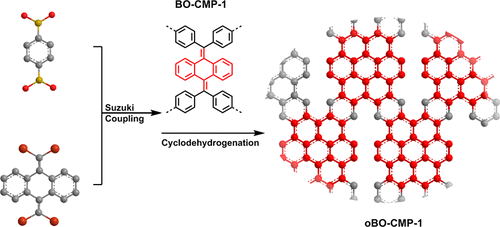当前位置:
X-MOL 学术
›
Macromolecules
›
论文详情
Our official English website, www.x-mol.net, welcomes your
feedback! (Note: you will need to create a separate account there.)
Conjugated Microporous Polymers with Extended π-Structures for Organic Vapor Adsorption
Macromolecules ( IF 5.1 ) Pub Date : 2018-01-17 00:00:00 , DOI: 10.1021/acs.macromol.7b02515 Si-Jie Yang 1, 2 , Xuesong Ding 1 , Bao-Hang Han 1, 2
Macromolecules ( IF 5.1 ) Pub Date : 2018-01-17 00:00:00 , DOI: 10.1021/acs.macromol.7b02515 Si-Jie Yang 1, 2 , Xuesong Ding 1 , Bao-Hang Han 1, 2
Affiliation

|
Conjugated microporous polymers (CMPs), which are organic porous materials with π-conjugated skeletons, have attracted considerable attention in recent years owing to their distinct properties. Here, two sp2 carbon CMPs with analogous structures, namely, BO-CMP-1 and BO-CMP-2, were prepared through palladium-catalyzed Suzuki–Miyaura cross-coupling reaction. BO-CMP-1 and BO-CMP-2 possess high surface areas and can be further modulated by postoxidation reaction to form networks with enhanced rigidity, as denoted by oBO-CMP-1 and oBO-CMP-2, respectively. The oxidation process transforms biolefin benzoquinone blocks within the skeletons into tetrabenzocoronene segments and endows the resultant oBO-CMPs with extended π-structures. The postoxidation provides a feasible approach to obtain CMPs with large π-systems. This approach prevents the disadvantages of direct synthesis by using monomers with extended π-structures, which often suffers low polymerization degree from strong π–π stacking of the monomers. The N2 and CO2 adsorption analysis confirms the effective changes in the parent materials during the oxidation process, suggesting that the approach can well modulate the porosities and adsorption properties of CMPs. Furthermore, owing to their aromatic nature, BO-CMPs and oBO-CMPs exihibit good affinity toward aromatic molecules, showing high uptake of benzene and toluene. For example, BO-CMP-2 captures 112.5 wt % toluene and 95.0 wt % benzene at 298 K and P/P0 = 0.99, indicating their promising capability to remove toxic organic vapors.
中文翻译:

具有扩展π结构的共轭微孔聚合物对有机蒸气的吸附
共轭微孔聚合物(CMPs)是具有π共轭骨架的有机多孔材料,由于其独特的性能,近年来引起了相当大的关注。在这里,两个sp 2通过钯催化的Suzuki-Miyaura交叉偶联反应制备具有相似结构的碳CMP,即BO-CMP-1和BO-CMP-2。BO-CMP-1和BO-CMP-2具有较高的表面积,可以通过后氧化反应进一步调节以形成具有增强的刚性的网络,分别由oBO-CMP-1和oBO-CMP-2表示。氧化过程将骨架中的双烯烃苯醌嵌段转化为四苯并并戊烯链段,并使所得的oBO-CMP具有扩展的π结构。后氧化为获得具有大π系统的CMP提供了一种可行的方法。这种方法通过使用具有扩展π结构的单体避免了直接合成的缺点,该单体通常由于单体强烈的π-π堆积而遭受较低的聚合度。N 2和CO2吸附分析证实了母体材料在氧化过程中的有效变化,表明该方法可以很好地调节CMP的孔隙率和吸附性能。此外,由于它们的芳族性质,BO-CMP和oBO-CMP对芳族分子表现出良好的亲和力,显示出苯和甲苯的高吸收。例如,BO-CMP-2在298 K和P / P 0 = 0.99时捕获了112.5 wt%的甲苯和95.0 wt%的苯,表明它们有希望的去除有毒有机蒸气的能力。
更新日期:2018-01-17
中文翻译:

具有扩展π结构的共轭微孔聚合物对有机蒸气的吸附
共轭微孔聚合物(CMPs)是具有π共轭骨架的有机多孔材料,由于其独特的性能,近年来引起了相当大的关注。在这里,两个sp 2通过钯催化的Suzuki-Miyaura交叉偶联反应制备具有相似结构的碳CMP,即BO-CMP-1和BO-CMP-2。BO-CMP-1和BO-CMP-2具有较高的表面积,可以通过后氧化反应进一步调节以形成具有增强的刚性的网络,分别由oBO-CMP-1和oBO-CMP-2表示。氧化过程将骨架中的双烯烃苯醌嵌段转化为四苯并并戊烯链段,并使所得的oBO-CMP具有扩展的π结构。后氧化为获得具有大π系统的CMP提供了一种可行的方法。这种方法通过使用具有扩展π结构的单体避免了直接合成的缺点,该单体通常由于单体强烈的π-π堆积而遭受较低的聚合度。N 2和CO2吸附分析证实了母体材料在氧化过程中的有效变化,表明该方法可以很好地调节CMP的孔隙率和吸附性能。此外,由于它们的芳族性质,BO-CMP和oBO-CMP对芳族分子表现出良好的亲和力,显示出苯和甲苯的高吸收。例如,BO-CMP-2在298 K和P / P 0 = 0.99时捕获了112.5 wt%的甲苯和95.0 wt%的苯,表明它们有希望的去除有毒有机蒸气的能力。











































 京公网安备 11010802027423号
京公网安备 11010802027423号